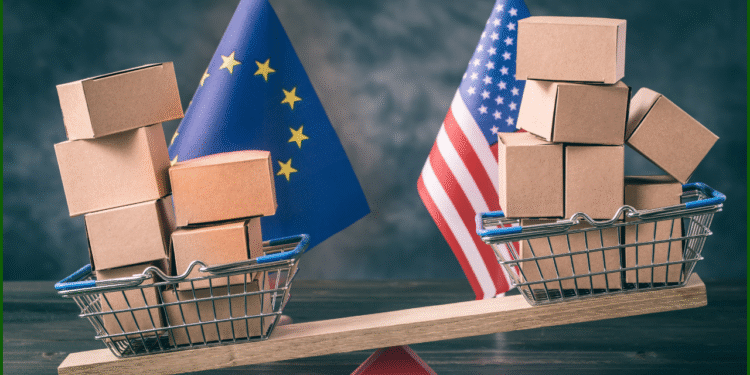President Trump’s threat of 50% tariffs on EU goods via social media has reignited global trade tensions, risking economic fallout and straining transatlantic relations as markets brace for impact.starting June 1 and warning tech giant Apple of a potential 25% import tax on iPhones sold in the U.S. The dual declarations sent shockwaves through financial markets, erasing weeks of cautious optimism surrounding trade de-escalation.
The S&P 500, a key market index, dropped 1% in early trading, while the Nasdaq slid 1.2%. European markets faced steeper declines, with shares falling 1.5% as investors grappled with the renewed uncertainty. The SPY, tracking the S&P 500, was trading at $580.62, down from its previous close of $583.09, reflecting the market’s reaction to the news. Similarly, Apple’s stock (AAPL) fell 2.5%, with its current price at $196.17, down from $201.36 the prior day.
Trump’s latest move targets the European Union, which he accused of stalling in trade negotiations. “The EU has been dragging its feet, and we’re done waiting,” he posted on Truth Social. “A 50% tariff will get their attention.” The proposed tariff would affect a wide range of EU exports, from German automobiles to French wines, potentially increasing consumer prices across the U.S. Last year, the EU exported approximately $566 billion in goods to the U.S., with key contributions from Germany ($161 billion), Ireland ($72 billion), and Italy ($65 billion). Major export categories include pharmaceuticals, vehicles, and chemicals.
U.S. Treasury Secretary Scott Bessent, speaking on Fox News, framed the tariff threat as a strategic push to accelerate negotiations. “We’re seeing progress with other partners, but the EU needs to step up,” he said. EU officials, however, remained reserved. The European Commission declined to comment directly, noting an upcoming call between EU trade chief Maros Sefcovic and U.S. trade representative Jamieson Greer. EU envoys are also scheduled to convene in Brussels to discuss the escalating situation.
In a parallel move, Trump singled out Apple, demanding that iPhones sold in the U.S. be manufactured domestically. “Tim Cook knows my expectations—iPhones must be made in America, not India or anywhere else,” he wrote. The proposed 25% tax on iPhones would mark a reversal of previous exemptions granted to tech imports, primarily from China. Analysts warn that such a tariff could significantly raise iPhone prices, given that the U.S. relies entirely on foreign manufacturing for smartphones, with over 60 million units purchased annually.
Industry experts expressed skepticism about the feasibility of Trump’s demands. “Relocating iPhone production to the U.S. would require massive infrastructure investment and years to execute,” said tech analyst Maria Gonzalez of DA Davidson & Co. “Apple’s recent $500 billion commitment to U.S. investments focuses on supply chain diversification, not domestic iPhone assembly.” Apple has been shifting some production to India to mitigate risks from U.S.-China trade tensions, but a full move to U.S. soil remains unlikely in the near term.
The tariff threats also raised legal concerns. Trade expert Laura Bennett of Akin Gump noted that targeting a single company like Apple could face significant hurdles. “There’s no clear legal framework for company-specific tariffs without extensive investigations, which could take months,” she said.
European leaders urged calm. Dutch Prime Minister Dick Schoof, speaking in The Hague, described the tariff threat as a negotiation tactic. “We’ve seen this before—tariffs are part of the back-and-forth,” he said. Volvo Cars CEO Hakan Samuelsson echoed this sentiment, expressing hope for a resolution but warning that high tariffs could render small-car imports to the U.S. unviable, passing costs to consumers.
Market analysts painted a grim picture. “Trump’s posts erased weeks of trade optimism in seconds,” said Sarah Khalid, a strategist at City Index. “A 50% EU tariff could disrupt supply chains and inflate prices on everything from cars to olive oil.” Citigroup’s Nathan Sheets added, “While I expect an agreement eventually, the EU-U.S. talks are the most precarious.”
As global markets brace for further volatility, the White House’s aggressive stance signals a return to the unpredictable trade policies that defined Trump’s earlier tenure. With negotiations ongoing and the June 1 deadline looming, businesses and consumers worldwide are left navigating an increasingly uncertain economic landscape.

















































